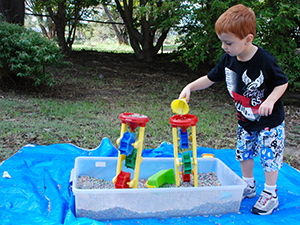Rice Play – Child
 Playing with rice fascinates children. Children may respond to sensory experiences like rice play in a variety of ways. Some children will dive straight in, while others may explore more cautiously.
Playing with rice fascinates children. Children may respond to sensory experiences like rice play in a variety of ways. Some children will dive straight in, while others may explore more cautiously.
Did you know?
It can be very calming to run your hands through a textured material like rice.
Rice play is a wonderful invitation to play and create imaginary worlds. Children benefit from having the space and time to explore in their own way and at their own pace.
Add language
During rice play, you can talk about how things move, feel, smell and sound. Make a comment, pause and wait. Give them a chance to add to the conversation. Ask occasional questions that require some thinking and reasoning e.g. “What would happen if we ….” “What could we use to ….” Encourage experimenting and exploring through these questions. This helps develop early science skills.
Rice play can give children something new and interesting to talk about. Many children will enjoy story-telling through ‘small world’ play. The imagination involved in creating a land of dinosaurs or a haven for mini-beasts provides opportunities for introducing new words and simple story-telling skills.
Other development
During rice play, fine motor strength (including the pincer grip when picking up tiny grains of sand) and hand-eye coordination are developed. These are helpful for handwriting later on at school.
Children can help to make coloured rice. Just put some rice in a zip lock bag and add food colouring and a touch of vinegar. Then squeeze and squish the bag until it’s all coloured. The rice will quickly dry. Children love being engaged in the creating process as well as playing.
Variations
Try different grains such as split peas, beans or wheat if you have these available. Comparing the different size, shape and sounds made by the different grains builds early maths and science skills.
You can make a discovery container by filling a jar with rice and other small items. Your child can think of items to include. They can collect them from around the house. Try including some small metal based items such as paper clips, metal buttons or small lengths of pipe cleaners. Then rub a magnet along the side of the container. Watch what sticks to the magnet! This helps develop your child’s thinking and problem-solving skills.
Activities listed under “child” are suitable for children 3 years and older. Children of this age enjoy more complex activities where they can develop their skills and use their imagination while playing with friends.

